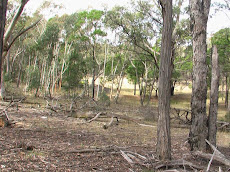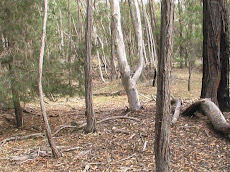 Please respect that all my paintings are here to be shared, enjoyed but not copied or printed. They are copyright to Carol Mead 2008. For more info email me - please pop into my profile to send me an email....
Please respect that all my paintings are here to be shared, enjoyed but not copied or printed. They are copyright to Carol Mead 2008. For more info email me - please pop into my profile to send me an email....I have been painting in watercolours since 1996 when I took a class with the wonderful Janet Twigg-Patterson. I still have many of those first paintings and they still make me smile!
I love the delicate way watercolourcan be applied to paper, the colours and the way it is sometimes very hard to control.

While I do landscapes occaisionally, I usually paint flowers and leaves of the Australian Bush, and if they aren't available any flora is fine with me....... I have my own style of course and while my paintings are not 'botanical', in that they are very exact, they still have a botanical fee to them.

A few years ago I went into watercolour pencils as I usually paint in strange locations which is difficult with pallettes and water. I have painted in caravan parks, on card tables, under dull light, on the bed of hotel rooms, on the ground, on verandas and in the car. Watercolour pencils give me the freedom to paint without the mess.
All I need is:
- 300gsm watercolour paper
- 2b pencil, eraser, sharpener
- Watercolour pencils (1 have about 40)
- A ink pen for lining - black, permanent and fine
- A small paintbrush - I use a white size 4
- A container of water - I use a vitamin container
- Tissues - 2 or 3
- A glass with water in it for my flower I am painting
The Paper: While you can get watercolour paper that is thinner (say 190gsm), I have found that it buckles. I am lazy and I don't like to stretch my paper - and I am often not somewhere that I could do this even if I wanted to....so I use the pad of 300gsm paper and I like a rough surface rather than a smooth because I like the effect of the paint int eh furrows of the paper. I don't use the paper though with lots of little grooves......as I don't like the stripey effect it makes. But each to their own!! usually I paint on A5 and A4 sizes, but if I am painting at home I sometimes use A3 but find this to large to handle out in the field.....
The flower: All I can say about this really is it must be something you relate to.... the shape, the colour, the leaves......you will paint it much better if you like it. I love roses..... but I hate painting them, I think it is because I try to draw and paint each petal and they are very complex. But I love lillies, gums, fushias, irises, butterfly bush, daisies, hakeas and so much more so I don't paint roses - I grow and photograph them instead.
Study of the piece: Each painting is unique as I study the flower (or leaves etc) very thoroughly and ensure I know how it is put together (that is the almost botanical bit). And then I have to admit that I may remove some bits I don't want to paint (this is decidedly unbotanical!!).
Drawing of the Flower: The view also might be scewed because I might paint in a leaf or bud....that isn't there at all (the botanical painters will be have apoplexy about now!) for me it is all about the presentation and if I need to put in or take away something then that is what I do.
Watercolour Pencils: I draw it carefully with the 2B pencil and then start to build in colour. In watercolour pencils you need to think not only in form but the colour has to also do your shading of light and dark. There is a real need to practice this and it is the most common reason I have found which stops people developing a love for this medium.
Making Magic: Then I take my paint brush load it with water and blot the excess off the brush onto a tissue and start to work on the paint. The painting starts to take on it's true colours....and it is magic! I paint pieces of the work at a time, say the leaf, before moving on to another area. I take care not to touch an adjacent area of the work as the water (with paint) will run into the next area which I don't want to happen.
Darkening the Painting: I leave the painting for a few minutes to settle while it dries and then I may touch areas up with a darkening colour if it needs it. All I do is hold the pencil and wet the tip with a wet brush, blot as before and then paint in the colour, blending as I go.
Lines on My Work: I also may chose to draw in areas of the plant but not colour them..... This is something I like to do when I think it suits the piece. I then line my work, very carefully and this must be done when the painting is dry, including the part that is drawn but not painted. Once it is very dry, after an hour or so, I gently erase any lead pencil lines. Then I sign it of course!
One day I want to exhibit my work and sell some pieces.











1 comment:
Carol
Isn't it amazing when you see a side of someone who you've known so well in another aspect of their lives.... These are simple beautiful!
Bec
Post a Comment